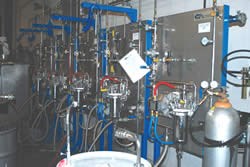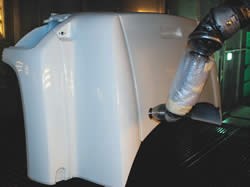Productive Plastic Painting
Upgrades improve paint system flexibility, application characteristics
Continental Structural Plastics (CSP) is North America’s largest producer of sheet molding compound (SMC) and glass-mat thermoplastic (GMT) composite parts for the automotive, heavy truck and other industries. The company operates multiple plants, using compression molding to produce fiberglass-reinforced hoods, fenders and other components for suppliers to General Motors, Chrysler, International Truck and John Deere, among other customers.
CSP’s plant in Carey, OH focuses mainly on producing automotive and heavy truck body panels. Until recently, the plant did no finish painting of panels. Instead, finishing at the facility was limited to robotic application of electrostatic primer to components running through the plant’s single paint booth.
However, that is all beginning to change, and CSP-Carey has had to significantly upgrade its finishing capabilities to meet the requirements of a new customer for finished heavy truck hoods and other components. The customer, Hino Diesel Trucks (USA) Inc., is majority-owned by Toyota, and the company is pushing to gain share in the U.S. heavy truck market.
“When we acquired these contracts, we accepted that significant technical improvements must be made to our existing paint application systems,” says Rick Kibby, Director of Corporate Operations. The company asked the 200 Carey plant employees for suggestions to make operations more flexible, efficient and more productive.
Finishing Opportunity
With this mandate, Carey paint operations manager Chris Twining saw an opportunity to upgrade the plant’s paint process. He recognized that an efficient paint process capable of applying multiple colors of one- or two-component materials would not only save the business considerable expense and produce superior product, but would also allow CSP to supply product to a much broader market.
Twining had been hand-cuffed for years by restrictions on spending, but the mandate for more flexible finishing to meet Hino’s requirements opened up an opportunity to upgrade the plant’s paint system. “Our first priority was to meet new contract requirements for paint application and quality,” Twining says. “But we also wanted to lift our current level of quality and efficiency for all products in a way that would benefit all our customers.”
According to Twining, the plant’s paint system was unnecessarily complex and added significantly to process rigidity and operating costs. Some of the issues stemmed from the polymer-based parts being processed at Carey. “We painted non-conductive parts with a conductive primer using conventional and electrostatic air-atomized guns mounted on robots in an extremely complex, high-volume automated system,” Twining explains.
“We wanted bells. We required reliable two-component (2K) flow control integration. We wanted total paint supply flexibility and efficient process control.”
Twining invited suppliers to quote, and all but one provided piecemeal proposals for parts of the project. “A.B. Myr Industries was the only company to provide a comprehensive well designed plan,” Twining says.
CSP had previous experience working with the Belleville, MI-based company. “We had been pleased with the engineering work they were providing on modifications to our booth and air houses, but I was not aware of the company’s expertise in robotic paint applications,” Twining says.
Plant personnel and A.B. Myr engineers undertook a study of paint application system modifications required to meet the plant’s upgraded finishing requirements. The vendor then presented a recommendation detailing all improvements, equipment specifications, and process controls that would result in significant performance gains.
The main challenge was to upgrade CSP’s single-primer coating application system to a multi-color capable system. The new system accomplishes this by:
- Enabling parts to be coatedwith a primer or one of four paint colors as it passes through the paint spray booth.
- Continuously recirculating paint in the lines to supply paint to the booth at a steady, controllable rate, free of pulsations and fluctuations.
- Supporting piggable system cleaning to enable fast color changes and virtually eliminate paint waste.
- Automatically controlling paint temperature in the system to maintain manufacturer’s specifications. This enables newly delivered paint drums, which are either hot in the summer or cold in the winter, to be immediately connected and used. It also eliminates having to environmentally control the paint storage room.
-
Upgrading paint application technology to reduce paint overspray by more than 50% and increase transfer efficiency
by improving grounding, application of conductive primer and use of robot-mounted bells to replace spray guns.
System Upgrades
The new piggable paint system can handle five paint colors. Each color has its own pumping system and piping network and thus is available for use at all times. The system minimizes paint waste and color change time, as paint engineer Jeremy Renwand explains.
“The paint system can now handle primer and three different colors at a time, plus a hardening agent for the 2K paint,” Renwand says. “Piggable systems save paint and facilitate color changes.”
By keeping multiple paint colors available at all times, the system minimizes color change frequency. When a color change is required, CSP can now quickly change colors with virtually no paint material waste. According to A.B. Myr, 96% of paint is recovered during a color change, and each change requires less than 1 gal of solvent.
Piggable color change valves allow the pig to pass through the color change manifold, minimizing dead spots between the valve and manifold. Quick-disconnect air-tight fittings and integrated efficient pig launch and retrieval processes further shorten color change time.
At CSP, the pig, a bullet-shaped bit of polyurethane foam that’s introduced into the paint system at the end of a color run, takes approximately 30 sec to make its way through the system. This is followed by alternating bursts of air and solvent—referred to as a solvent chop—to clean the lines. A second pig removes the solvent from the lines and the system is ready for the next color.
“The maximum time for a color change with this system is probably about 10 min,” Renwand says. “You lose very little paint with the piggable system, and you use very little solvent.”
In a non-piggable paint system, color changes can waste up to 6 gal of paint and require a high volume of solvent to flush the line; plus increase costs of wasted paint and solvent disposal. Color changes may be required many times a day, causing expensive paint waste, solvent usage, labor and downtime.
New Paint Process
CSP’s finishing process begins when parts are loaded onto carriers for their trip through the paint line at approximately 15 fpm. Each carrier has a bar code that is read before parts enter the paint booth. The bar code reader tells the system what part is coming through the booth, and the right instructions are sent to the robots based on the carrier number,” Renwand explains.
Parts are first cleaned using a five-stage spray washing process. Parts exiting the washer are dried thoroughly before they enter the paint booth, where a conductive primer is applied. Since electrostatics cannot be used until parts are conductive, the conductive primer is applied using conventional spray application equipment.
In the paint booth are six robotic applicators; normally the first robots apply the primer and the top coat is applied a bit further down the line. “Right now we’re batching Hino parts and priming them first,” Renwand explains. “Then they’ll go back around to receive one of four monocoat colors.” Even with multiple colors available at all times, CSP anticipates 10–20 color changes a shift.
Flow of the base resin and catalyst (hardener) components of the 2K paints is automatically controlled by flow meters that measure precise amounts of each component needed to paint each part. Painted parts enter an overhead oven where they cure for approximately 1 hr at 300°F. CSP aims for a nominal paint thickness of 1 mil including primer.
The new finishing system is helping CSP grow its automotive business as OEMs strive to reduce vehicle weight and increase fuel efficiency by using composite panels, hoods and parts in place of their traditionally metal counterparts. The advanced multi-color paint system gives paint line managers the ability to paint parts passing through the booth in any color. The system’s operator interface facilitates management of real-time process parameters.
In the booth, the performance of the new rotary bell atomizers, coupled with flexible process control and efficient robot programming, substantially increased paint application flexibility. “The gains in overall system performance were dramatic,” Twining says. “This paint shop is now producing a surface appearance with significantly improved wave, gloss, and color characteristics. Paint application-related defects have diminished, booth up-time and throughput have increased, and most overspray has been eliminated. And, these results have been achieved with a reduction of paint usage greater than 25%.”
Related Content
Masking Solutions Provider CFS Dramatically Expands Capabilities and Capacity
Custom Fabrication & Supplies (CFS) completed a new plant expansion packing 10 times the capacity into twice the space. It dramatically enhances the supplier’s custom capabilities to provide extremely precise and cost-effective masking solutions.
Read MoreMix of Automation and Skilled Employees Generates Quality
This Pennsylvania plating company’s general manager shares insights about being recognized as a Top Shop for several consecutive years as well as his thoughts about automation, customer service, hiring skilled workers, the challenges of installing a new line and more.
Read MoreSurface Prep Solution for Rusted Rebar in Concrete
Julie Holmquist of Cortec Corporation discusses passivating corrosion on rebar and other reinforcing metals.
Read MoreShedding Light on Surface Inspection
State-of-the-art reflector-based lighting system improves luminosity and ergonomics for surface inspection tasks while reducing energy usage.
Read MoreRead Next
A ‘Clean’ Agenda Offers Unique Presentations in Chicago
The 2024 Parts Cleaning Conference, co-located with the International Manufacturing Technology Show, includes presentations by several speakers who are new to the conference and topics that have not been covered in past editions of this event.
Read MoreDelivering Increased Benefits to Greenhouse Films
Baystar's Borstar technology is helping customers deliver better, more reliable production methods to greenhouse agriculture.
Read MoreEpisode 45: An Interview with Chandler Mancuso, MacDermid Envio Solutions
Chandler Mancuso, technical director with MacDermid Envio discusses updating your wastewater treatment system and implementing materials recycling solutions to increase efficiencies, control costs and reduce environmental impact.
Read More
















.jpg;maxWidth=300;quality=90)








